If you’ve heard an unplugged electric guitar before, you probably know just how quiet they are. You can barely hear them. Fortunately, they have pickups, which convert the barely audible sound to an electric current, and that signal is later amplified. We know that electric guitars have pickups, but can you use a pickup on an acoustic guitar? Or are they exclusive to electric guitars only?
You can use a pickup on an acoustic guitar. There’s a device called a soundhole pickup for amplifying the sound of an acoustic guitar without modifying the instrument itself.
Pickups can be installed on an acoustic guitar. There are temporary versions that can be installed in the soundhole, and there are more permanent versions that require reaming the endpin to install a ¼” jack.
Soundhole pickups are an excellent choice for acoustic amplification without high costs or making any permanent alterations to your guitar. If you’re interested in seeing what all it will take to install a permanent pickup, check out this how-to over at Music Radar.
Otherwise, this article will cover soundhole pickups. Here are the two soundhole pickups that I recommend.

What Does a Soundhole Pickup Do?
There’s a device called a soundhole pickup for amplifying the sound of an acoustic guitar without modifying the instrument itself. What exactly does a soundhole pickup do?
Soundhole pickups are installed in the soundhole of an acoustic guitar designed to convert the movement of the string into an electrical signal. The signal is sent through a wire coming from the pickup, which can typically be plugged into a ¼” plug, like what you would find on an amplifier.
Soundhole pickups are temporary, easy to use, and accessible, making them a popular choice among guitar players who need to amp their acoustic guitar.
Soundhole pickups are excellent devices for acoustic amplification without high costs or hassle.
Does Soundhole Pickup Affect Sound?
This is the first question I asked when I first learned about soundhole pickups. You are physically putting something in the soundhole. Does a soundhole pickup impact the sound?
A soundhole pickup will alter the acoustic sound of your acoustic guitar by shifting the resonance frequencies that are emitted from the soundhole and minimally dampening the guitar due to the weight of the pickup.
If the soundhole pickup is a piezo-electric pickup, like those used on electric guitars, the output signal sent from the pickup will sound different than if you were to play your acoustic without a pickup.
So, as you can see, there are two different avenues you can take when asking how a soundhole pickup will impact the sound of your guitar. One is the acoustic sound, and the other is the electric sound.
Soundhole Pickup Affect On Acoustic Sound
MIT (Massachusetts Institute of Technology) has actually done research about air resonance through sound holes of various instruments. I find the pieces of information quite intriguing, so here are links to two of the research articles from MIT:
I know the first one is about violins, but it talks about how the shape of the soundhole affects acoustic amplitude. That means changing the shape of the soundhole, such as putting a pickup across it, will change how loud your acoustic guitar sounds, not to mention the added weight of the pickup against the soundboard.
Secondly, the articles mention how the shape of the soundhole helps shape the resonance frequencies, meaning that placing a pickup across the soundhole will change your resonance frequencies.
It’s also worth noting that their study found that most of the air resonance flows through at the outer rim of a round soundhole. Placing a soundhole pickup makes the soundhole not completely round anymore. The study has some complex calculus for determining the airflow, so go check it out if you are mathematically inclined.
Soundhole Pickup Affect On Electric Sound
Obviously, there will be no electric sound without a pickup because you can’t send a signal to an amplifier.
I think Fender sums it up nicely. “Soundhole pickups consequently produce a warm, full, and distinctly electric-sounding amplified acoustic tone,” says Fender in an article about acoustic guitar pickups.
The sound that soundhole pickups produce is similar to that of electric guitars because they work the same way. The pickups are not capable of picking up the resonant frequencies that are produced by the guitar.
When playing, the acoustic guitar’s body resonates, and there are sound waves that bounce all around inside. That’s why acoustic guitar manufacturers spend so much time on their internal bracing. If you need an example, look at Taylor’s V-Class bracing, found on their website here.
How Do You Use a Soundhole Pickup?
A soundhole pickup is relatively easy to use and doesn’t require much equipment other than the pickup itself, an amplifier, and sometimes a screwdriver.
Slide the Soundhole Pickup Under the Strings
Loosen the strings if necessary in order to slide the pickup under the strings. Make sure the wire exits towards the bottom of the guitar. It’s easier to slide it from the bottom of the guitar toward the top; that way, the wire does not get in the way.
Wedge the upper slot of the Soundhole Pickup onto the Soundhole
There is usually a slot in the pickup that will slide over the rim of the soundhole. Go ahead and slide the pickup on, but don’t firmly push it into place yet. There are a few adjustments that need to be made before the pickup is firmly installed in place.
Align the magnets such that they are directly under each string
The magnets aren’t always visible, but if they are, make sure they are aligned directly under the strings as best you can. This will give the magnets the strongest signal when the strings are played.
If the magnets are not visible, check the user manual of the pickup to see if it has recommendations on how the pickup should be aligned.
Make sure the Soundhole Pickup is firmly in place
Depending on the design of the pickup, you may need a screwdriver to tighten it, or you may just need to push it into place. It should be apparent by looking at the pickup if it has screws or not.
If it does require tightening screws, make sure to not over-tighten. This will damage the wood of your guitar. Tighten the screws just enough that the pickup stays in place.
Tune The Guitar and Start Playing
Now that the pickup is in place tighten back up your strings and make sure the guitar is in tune. Now that you have the pickup installed, you can plugin to a tuner!
Now you’re all set. You can now plug into an amp, your pedalboard, digital interface, or whatever you are using.
Reasons You Should Use a Soundhole Pickup
Using a soundhole pickup is a great way to meet particular playing needs. Let’s talk about why you should use a soundhole pickup and how it can benefit you and your acoustic guitar gigs.
A Soundhole Pickup Is Excellent for Live Performances
It can be almost impossible to hear an acoustic guitar in a live performance without being amplified. One option is to use a microphone, but even then, the mic can’t isolate the acoustic guitar sound like a soundhole pickup can.
Secondly, you can’t move around at all if you are using a microphone.
A soundhole pickup would be an excellent accessory for live performance because you can amplify the guitar and move around, even if it’s just a little.
If you know you’ll be performing on stage for a large crowd with your acoustic guitar or if you are playing with other instruments, consider getting a soundhole pickup to ensure you’ll get the sound and attention you need.
Soundhole Pickups are Affordable
A soundhole pickup is a popular acoustic guitar accessory because, compared to instrument modifications and pricier equipment, it is a cheaper option.
Soundhole pickups can run anywhere between $30 and $200, with some higher-end soundhole pickups selling at over $200. The cost depends little on the brand name and a lot on the features.
These features include humbucking pickups and selectable active or passive modes. You may not need those features if you’re just starting out using a soundhole pickup. An affordable, good quality and popular option is the Seymour Duncan Woody Soundhole Pickup.
You Don’t Have To Modify Your Guitar if You Have a Soundhole Pickup
Since acoustic guitars are sold as acoustic instruments and not electric ones, it’s common for people to modify their guitars to give the instrument the ability to be amplified.
There’s nothing necessarily wrong with modifying your guitar, but it does require cutting out holes in the body of your guitar, and that is not necessarily something I’m comfortable with. A soundhole pickup does not require any alteration to your guitar and can be removed anytime.
Modifications are a permanent change to your instrument. Most modifications are invasive to the guitar and can’t typically be undone, which can be a problem if the modification was done wrong or if you change your mind about the upgrades.
However, you get a temporary accessory with a soundhole pickup rather than a life-long alteration. This pickup can be applied and removed with ease, making it an excellent choice for those skeptical about modifying their guitar (like me).
Conclusion
If you want to give your instrument the ability to be amplified without modifying the guitar’s body, a soundhole pickup is a good idea. These pickups don’t require any permanent alterations to your acoustic guitar. They can be installed and removed as desired, making them an excellent choice for someone who wants the ability to amplify their instrument but isn’t willing to make permanent changes.
When it comes to playing an amplified acoustic guitar, there are many things to consider.
Hopefully, this article has provided you with some clarity about soundhole pickups and acoustic guitar amplification in general so you can make the best choices for both you and your beloved instrument.

